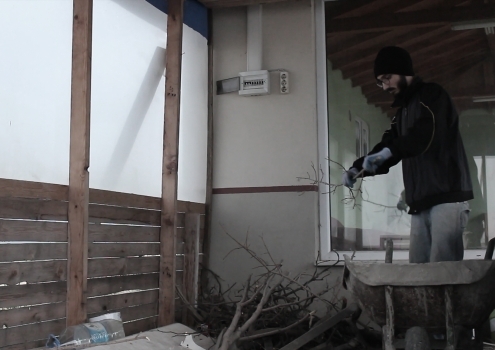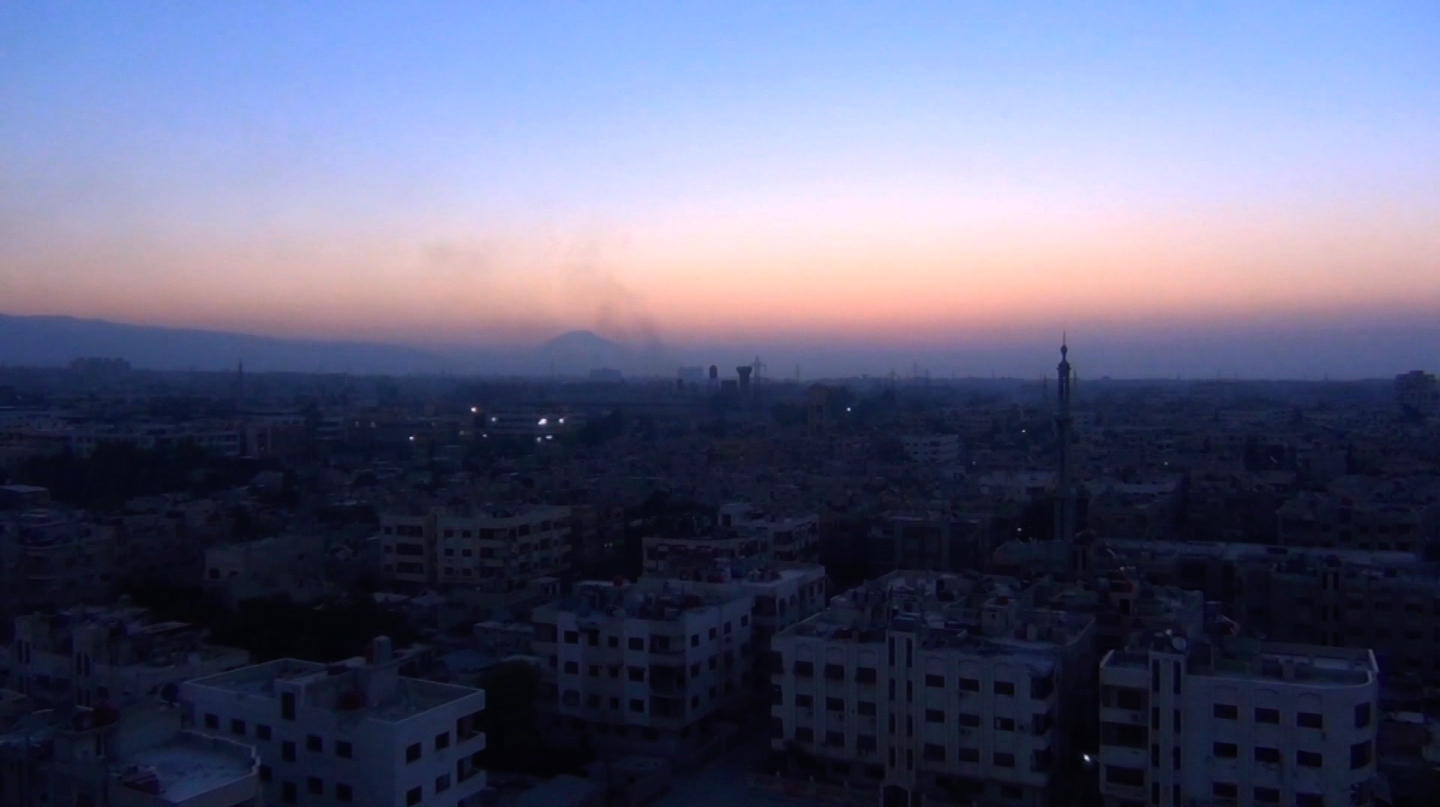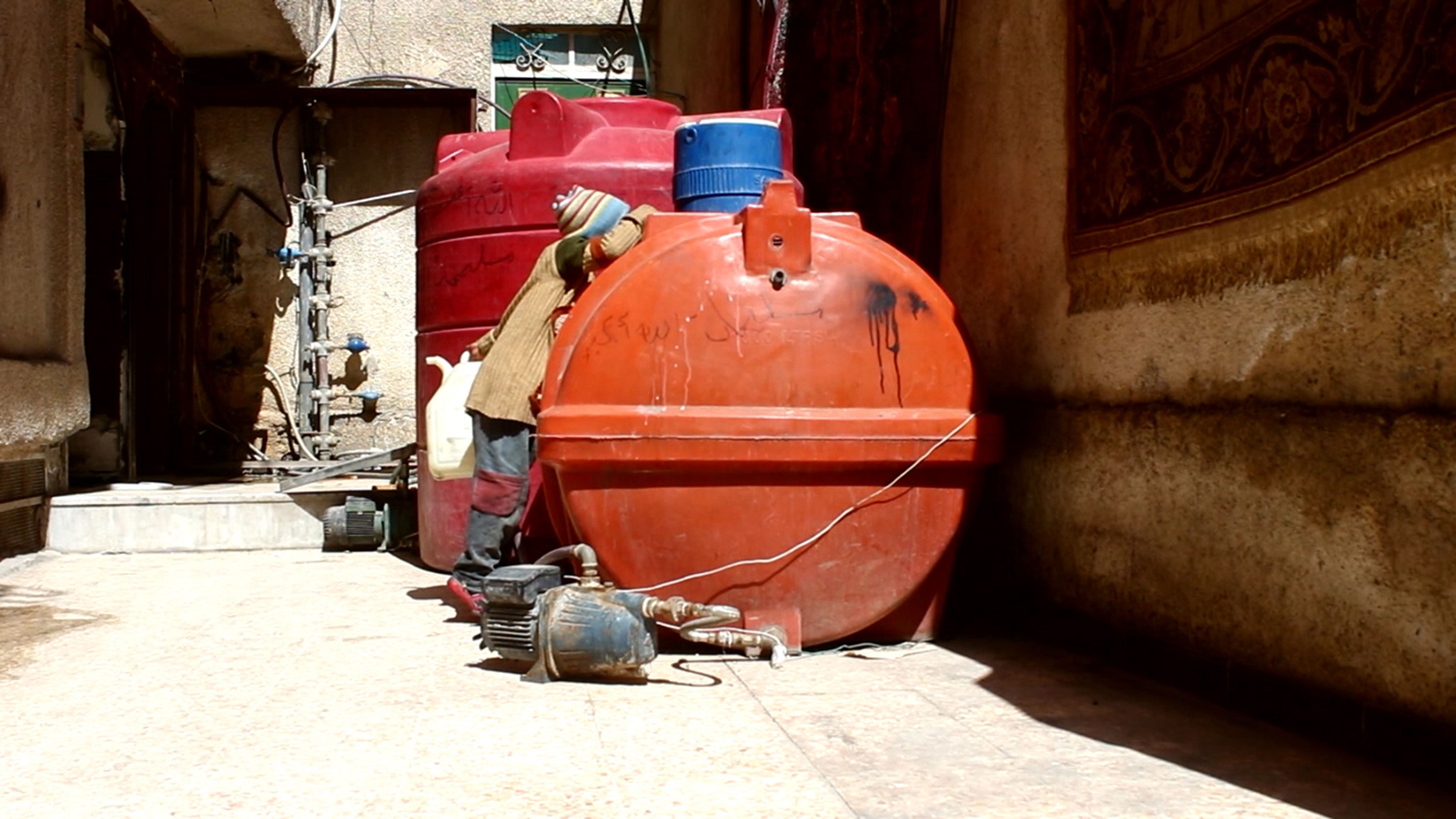
“Immaterial Collection,” a cinematic activity and event has been held in Beirut Art Center since 2015. Each part of the event deals with a different subject and a collection of cinematic performances pertaining to that subject is selected, and films are produced by artists that wish to participate. This month, and in the tenth part of “Immaterial Collection” the organizers have directed their interest towards presenting Syrian films, and three were chosen by the project coordinator Joy Stacey, a researcher residing in Lebanon.
In the introduction to the event’s brochure, we find out the reason behind this interest in a quote by the thinker Edward Said (1953-2003), where he discusses how facts come to form in human knowledge, and how it is impossible to rely on one narrator, even if he or she were an author or filmmaker. Said sees that facts are produced collectively and according to a collective sense, saying, ”the condition of truth is to expand beyond individual criterion, and this is what renders it truth.”
The organizers are applying Said’s quote on Syrian cinema and are inquiring as to how the Syrian event could be narrated. In the introduction to the brochure it says, “Narrating the aftermath of the Syrian catastrophe is as impossible as it is necessary, and therefore today we are presenting a variety of filmmakers who see their stories in different ways, employing the personal and the intimate, resorting to their own experiences and to their own language to find the characteristics that distinguish them in their works of art.”
Hence it is a question of how to narrate the Syrian event that compelled those interested to select these three works of art. It is an entertaining inquiry for the organizers, and I think that the answer is clear: the Syrian event is narrated by the multiplicity of narrators and the diversity of narrating techniques.
Frontline, 2014, Ghayat Haddad and Saeed Albatal, 13 minutes

The directors of this work follow the character that they chose to be the subject of their film, sniper Abu Abdo, who is busy alongside his comrades preparing for an expected clash between them and the regime forces.
In the first shot, the directors present photographic and editing techniques that dispel the receiver’s concern of watching a press report, as following a fighter’s life could be an ideal topic for press reports. On the cinema screen the first shot appears from the viewpoint of the sniper’s rifle, and the centre of aim is distorted whenever Fairouz’s voice is heard on the radio, and therefore the directors merge the distorted aim with the distorted radio signal, as the film is as much about music as it is about Abu Abdo’s character.
The directors succeed in capturing the spontaneity of the fighter’s activities, in an attempt to capture the flow of their collective mood, from their conversations on Gaddafi’s death, to their discussions about the distance between them and the Abbasid Square. The film then returns to concentrating on the protagonist, the sniper digging in building walls to reach an adequate position to situate himself in.
Although the cameraman is asking one or two questions about the protagonist, the center of his film, according to Noé Mendelle’s classification of documentaries(1) one could consider the film to belong to the genre of observational documentaries.
“Do you feel like you are killing? Or is it like you are playing?” No question is as important when encountering a fighter, or when you make a film about one. Through this question asked to Abu Abdo, we come to realize the purpose of the film is not to depict the ideal revolutionary fighter, as the inquiry occurs to the receiver from the outset: Why is the director depicting a fighter’s everyday life? What is the point of bringing the receiver closer to the life of a fighter? This concern goes through the receivers mind throughout the entire film, and then the cameraman asks the one carrying the rifle: Are you playing or are you killing with sorrow?” The receiver’s question resembles the filmmaker’s question, it is the fundamental question that allows the film to escape the orbit of political propaganda.
After this juncture, the audience is reassured that the director is impartial when recording the event: It is an observational documentary par excellence, embedding the scenes with the director’s own questions against the events that the camera attempts to capture as adequately as possible. Not forgetting that the element of music is of no less importance than the battles and the fighting, it is implicit throughout the film, particularly in the concluding shots when we hear a group of fighters discussing how to improve the radio’s signal and how to pick songs. With the sign of the end of the film, the receiver reads out the following statement, “Abu Abdo quit sniping, married and became a baker, and he continues to listen to Fairouz’s songs.”
The most remarkable scene in the film is that moment when Abu Abdo receives a phone call from his mother, he talks about his situation and asks about hers, but he does not take his eyes off the rifle’s scope. A conversation between a mother and her son proceeds without the fighter taking his eyes off the rifle’s scope. This shot cleverly inquires into the life of a fighter, and expresses its particularity profoundly. No doubt that accomplishing it in front of the camera might require efforts by the directors to build trust in the character’s spontaneity, and the patience in waiting for a signal in the narrative is that important.
Finally, the title of the film lacks a reference to the important subject that it addresses in addition to the life of the fighter, and that subject is music. In this film we are not only on the line of contact, but are introduced to what music is being played there.
Love During the Siege, 2015, Mattar Ismaeel, 16 minutes
The siege that tens of thousands of citizens south of the Syrian capital Damascus lived under for two continuous years. The siege led to the death of more than two hundred people due to lack of food and medical supplies. The film follows the life of a family trying its best to survive, relying on what the ground has to offer and what overflows from the garbage.
The title of film may clarify the message meant to be delivered through its scenes. Perhaps the idea seems simple, but the extreme conditions of the siege renders the experience of finding love through the events of the film an unforgettable experience for any viewer, touching on the proof cinematically. This scene was the most moving for the audience, and many articles were written about it.

The cameraman does not pose any question on the family members whom he films, and does not interfere with how the events transpire. According to Noé Mendelle’s classification, this film falls under the genre of participatory documentaries, not because of the cameraman’s interference but because the narrative unfolds from a specific viewpoint, that which the title indicates, and the camera attempts to be as impartial as possible but its purpose is to detect love despite the siege.
The director accurately achieves his goal at the visual level, and displays some aesthetic frames, particularly in the shots where he films the family outside the house walking in the streets, and the director succeeds in delivering a general atmosphere in the besieged area using shots that move the camera along with the family through the neighborhoods, and the frames deliver messages the director meant to deliver very delicately, warranting that one stops to appreciate them.
After following the family’s harsh living conditions throughout the entire movie, and as we accompanied them while they moved in the neighborhood, the camera displays statements written on the walls such as “Steadfast despite the siege,” or “Starvation is the weapon of cowards.” It is impossible to contemplate how these idealist statements and slogans facilitated and changed the increasingly harsh circumstances of the family.
This message, and this production of a paradox between the family’s situation and the revolutionary slogans emphasize two things: First, the professionalism of the director in terms of impartiality and objectivity, and second, the director’s ability to expand the technique of his narrative in his future work.
On the Edge of Life, 2017, Yasser Kassab, 45 minutes
The film, On the Edge of Life, suggests something different at the level of the subject and at the level of cinematic language.
Only a few works of art dealt with the refugee’s isolation, and the emptiness of exile. Rarely have immigrants or refugees attempted to convey their personal and poetic experience this profoundly.(2)
The narrator of the film and his partner exit the room where their first encounters took place in Aleppo and head to Beirut, and then to another place to reside in, in a house surrounded by highways and forests, considered by the narrator to be a house in the middle of nowhere, saying, “the sound of trucks that doesn’t stop creates this numbness, as if I were on the edge of life, outside of space and time, and the questions are multiplying as to why I came to this place, I no longer have a desire to speak.”
More than one text described this film as poetic and personal. This applies to what Noé Mendelle classifies as the poetic documentary as ”the genre that uses external material in order to express the internal state of the director.”
The elements of cinematic language are integrated to achieve this selfness and poeticism in the film’s style, from the lighting to the shadows and light, going through internal monologues used to express emotions and thoughts, intelligently avoiding the narration of events. It is a directing skill to reach the emotional and poetic condition that the director wants to relay to the receiver, and here is a statement the narrator says in his own voice, “In front of the mirror, I wish I had no reflection, and that everything turns out to be only a nightmare, I wish I would wake up and find myself in a different time.”
From the first shot in the film, the director relies on poetic frames: the window to his beloved room with jasmines in Aleppo, the nightlights in the streets of Beirut, details of the forest next to his house, and a final contemplative scene from the window of a train.
The receiver does not realize from the outset the reason behind this cinematic language, particularly that it imposes a slow rhythm on the film, but at the end it appears to be serving the message that the filmmaker wants to weave, namely, the emptiness of exile without a cause, and the silent rhythm away from from dreams and struggle.
But how does one express this silence and emptiness through cinema, the mediator which relies on the image and the event? For this purpose the director depicts everyday activities, expanding the frame so that the scenes appear to have empty spaces, he displays mundane everyday activities, like a broom that tries to sweep the dust off the sidewalk, a cat being fed multiple times, watching the rain through the window, and a shot of a butterfly trapped in a glass lamp evidently signifying impotence symbolically. Referential films that may help the reader to imagine this cinematic technique include the director Gus Van Sant’s film “Last Days” (2005) on Kurt Cobain, and the excellent work “The Time that Remains” (2009) by the Palestinian director Elia Suleiman.
Noé Mendelle includes in her description of the genre of the poetic documentary an unexpected feature, namely the ability to include political messages. Perhaps this feature appears at odds with self-poeticism, but “On the Edge of Life” undoubtedly serves as good evidence for her accuracy, as the film clearly delineates that the loss of a political cause is a harsh experience that leads to a feeling of emptiness. In the narrator’s last statements, he says, “I am a different person than the person who left Syria when he was 25 years old, a different person than the one who wanted to talk about freedom and the motherland. I am only a body, a body without a cause, without a spirit, without emotions. A body incapable of crying, burdened by impotence and uselessness with his life and memories stolen from him.”
At the end of writing about the film “On the Edge of Life,” and regardless of whether the filmmaker actually felt like what the narrator expressed, a body without a cause, then this movie allows us to recommend cinema and filmmaking as a perfect cause.
1- Noe Mendelle: Founder and Director of the Scottish Film Institute. Two video presentations presented on the site of the beginnings explain: First: What is the creative documentary? In the second, she explains her approach in categorizing documentaries into six basic categories: documentary, participative, poetic, intellectual, intellectual, and diaries. Of course, Neue Mendel explains that the identification of items for the sake of knowledge and perception, but in the works of art, the overlap and mix of varieties is a creative addition.
2- Among the distinguished texts dealing with the subject of emptiness, boredom in exile, a text entitled “Implications in exile,” (2015), and another “In what I call exile” (2016) were penned by Duha Hassan. The two can be found on Al-Jumhuriya.net.






